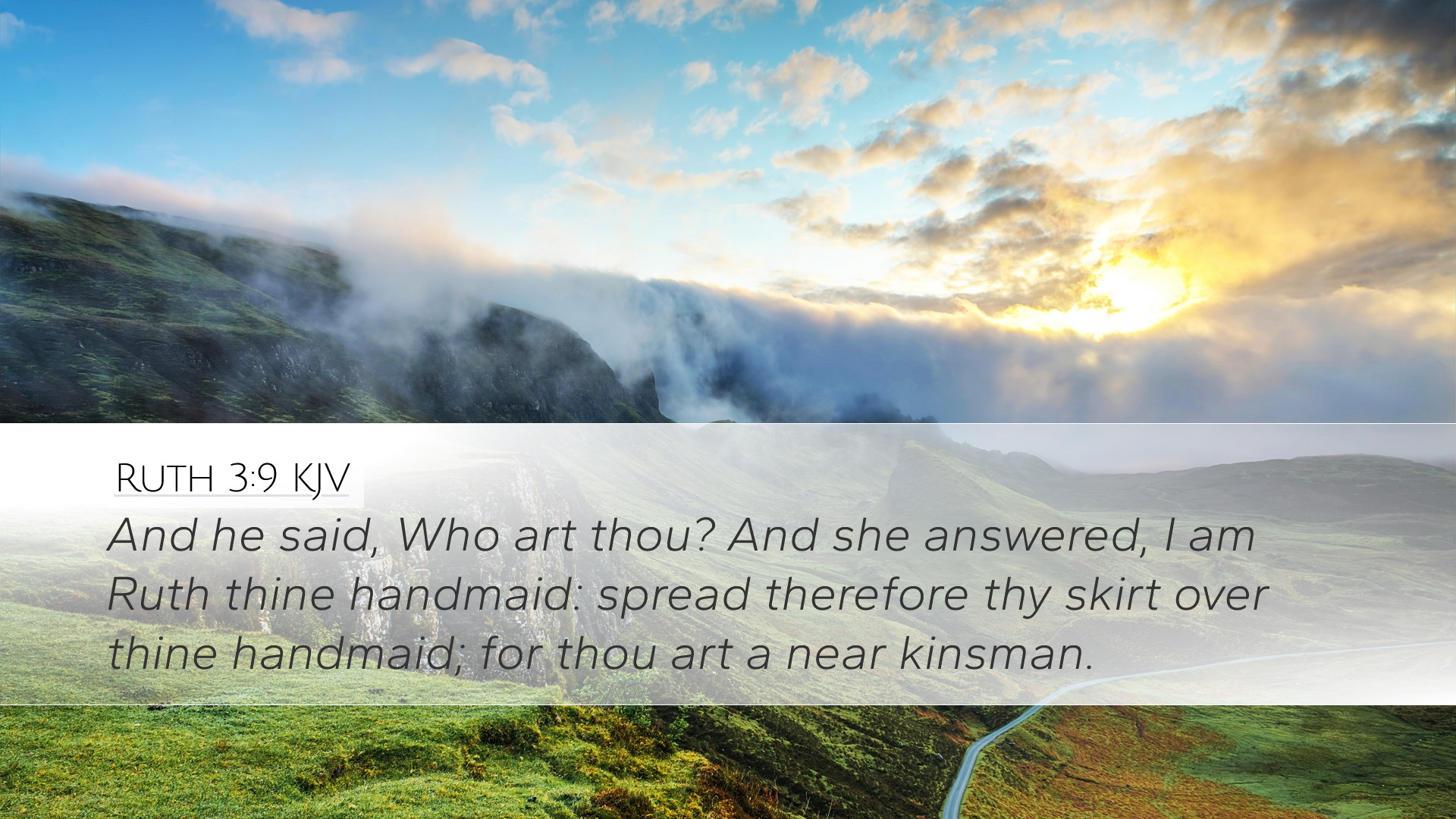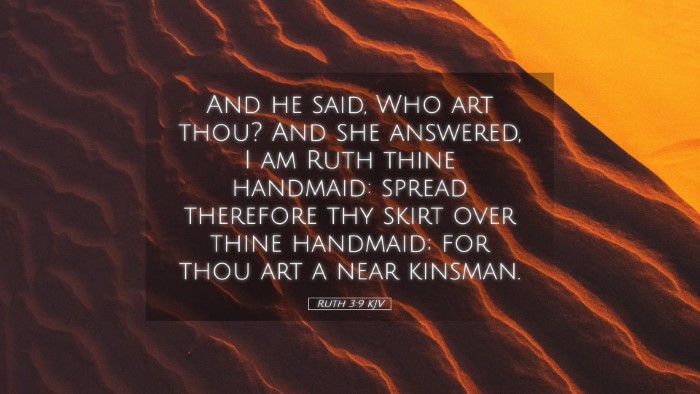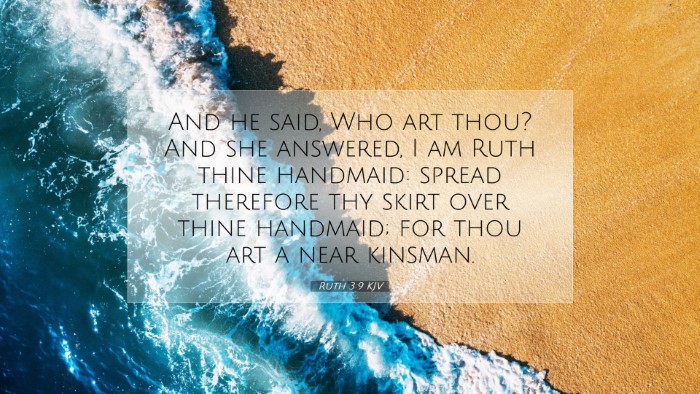Old Testament
Genesis Exodus Leviticus Numbers Deuteronomy Joshua Judges Ruth 1 Samuel 2 Samuel 1 Kings 2 Kings 1 Chronicles 2 Chronicles Ezra Nehemiah Esther Job Psalms Proverbs Ecclesiastes Song of Solomon Isaiah Jeremiah Lamentations Ezekiel Daniel Hosea Joel Amos Obadiah Jonah Micah Nahum Habakkuk Zephaniah Haggai Zechariah MalachiRuth 3:9
Ruth 3:9 KJV
And he said, Who art thou? And she answered, I am Ruth thine handmaid: spread therefore thy skirt over thine handmaid; for thou art a near kinsman.
Ruth 3:9 Bible Commentary
Commentary on Ruth 3:9
Verse: "And he said, Who art thou? And she answered, I am Ruth thy handmaid: spread therefore thy skirt over thine handmaid; for thou art a near kinsman."
Overview
The book of Ruth exemplifies themes of loyalty, providence, and redemption, encapsulated through the poignant interchange between Ruth and Boaz in chapter 3, verse 9. In this intimate encounter, Ruth, a Moabite widow, approaches Boaz, demonstrating her trust in God’s providential plan for her life and the life of Naomi, her mother-in-law. This verse encapsulates Ruth’s humble request for protection and her acknowledgment of Boaz's role as her kinsman-redeemer.
Insights from Public Domain Commentaries
Matthew Henry's Commentary
Matthew Henry emphasizes the courageous and bold nature of Ruth’s approach to Boaz under the cover of night. She identifies herself as his handmaid, a term of humility and submission, signaling her recognition of Boaz’s authority and status. By asking Boaz to "spread his skirt" over her, she is not merely requesting physical protection but is also invoking the Levirate marriage custom, seeking to secure her position and lineage within Israel.
Albert Barnes' Notes
Albert Barnes elucidates the cultural implications of Ruth's actions. The phrase "spread therefore thy skirt over thine handmaid" metaphorically represents a request for marriage or a claim to kinship. This act is laden with significant social and familial contexts, as it implies a deeper bond and a commitment to her welfare as part of Boaz’s household. Barnes notes that Ruth’s appeal demonstrates both her faith and her understanding of Israelite customs regarding redemption, positioning Ruth as a model of faithful obedience.
Adam Clarke's Commentary
Adam Clarke draws attention to the remarkable boldness of Ruth, who, despite her status as a foreigner, approaches Boaz with confidence. Clarke notes that her plea transcends mere protection; it signifies her dependence on Boaz’s mercy and kindness. Additionally, Clarke explains that Ruth’s request to Boaz acts as a catalyst for the redemption narrative that follows, emphasizing God’s orchestration of events in fulfilling His promises to Israel. Clarke highlights the theological significance of this moment as a precursor to the acknowledgment of Christ, the ultimate Redeemer.
Theological Implications
Ruth 3:9 provides a profound indication of God's providential care and the unfolding plan of redemption that permeates the Scriptures. Boaz is depicted as a Christ-like figure, embodying the qualities of mercy, grace, and the duty of a redeemer. The dynamics of the kinsman-redeemer concept present in this verse reflect the broader spiritual truths regarding the nature of redemption through Christ, who fulfills the ultimate role of Salvation for humanity, securing protection and a new identity for believers.
Practical Applications
- Faithfulness: Ruth’s unwavering loyalty to Naomi and her commitment to follow God’s lead highlight the importance of faithfulness in our relationships.
- Courage: Ruth’s boldness serves as an inspiration for believers to step out in faith, trusting God’s plan even when circumstances seem daunting.
- Redemption: The concept of redemption encourages Christians to reflect on the redemptive work of Christ in their own lives and to extend grace and mercy to others.
Conclusion
Ruth 3:9 is a pivotal moment in the narrative of Ruth, painted against the backdrop of a time of turmoil in Israel. The interplay between Ruth and Boaz encapsulates themes of loyalty, trust, redemption, and the providence of God. As pastors, students, and theologians study this verse, they are reminded of the overarching message of God’s redeeming love, experienced through Christ, and the call for believers to live in the light of this truth. Indeed, this verse is not just a historical account but a vital connection to the redemptive story that runs throughout the Bible.


